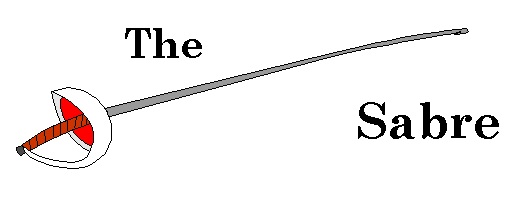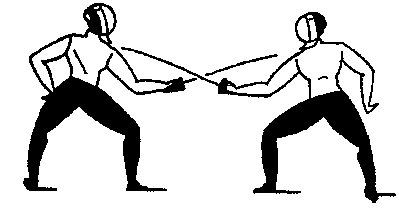

In the eighteenth and early nineteenth centuries, the cavalry of all nations practised sabre fencing and fighting.
In the eighteenth century the small-sword was regarded as essentially the gentlemen's weapon and from association with it, the foil enjoyed much the same prestige; the sabre was considered to be a rather crude affair for the military. The Napoleanic Wars aroused a passing enthusiasm for edged weapons, but this quickly faded again. George Roland poured scorn on the sabre and most traditionally minded foilists affected to regard it with disdain. Only at the nineteenth century's end did such great Italian Masters as Radaelli and Magrini confer respectability on their chosen weapon, since when it has gained steadily in popularity.
The present day weapon is extremely light and hits may be scored not only with the fore-edge, but with the top third of the back edge and the point as well. The contemporary blade is perfectly straight, but within the writer's memory, many still possessed a vestigial curve which, according to the rules, might not deviate more than 4 cm from the straight line. The curved, triangular guard, reminiscent of the old basket-hilt, must now be absolutely smooth; formerly, it was often perforated, grooved, patterned or embossed.
The technique of the cut has traditionally been the subject of controversy and has undergone sundry vicissitudes over the years. The military men delivered the cut with a forearm slash from the elbow, or even the shoulder. The great Keresztessy of Budapest, however, preferred the use of the wrist. That was in the 1820s, but when Barbasetti arrived from Italy at the century's end to take charge of the Austrian Army, he insisted on a return to the forearm method, a retrograde step, but consistent with the contemporary principles of his own country. It was left to Santelli, another Italian expatriate, to introduce in Hungary the classical wrist-finger technique regarded as characteristic of that nation and now almost universally copied. Modern sabre fencing has rules and conventions similar to those of foil; they were framed in Paris in 1914 by a committee under the chairmanship of Dr. Bela Nagy, president of the Hungarian Fencing Federation, and since then have only been modified in detail.
-taken for the A-Z of Fencing by E.D. Morton
-taken from the USFA Fencing Rules 1991 Edition

Valid target is in white.